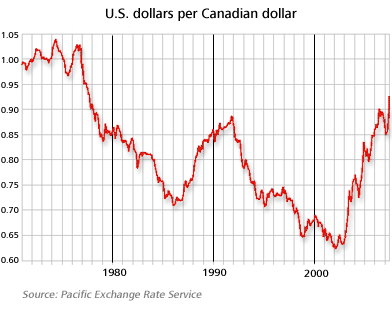
In Depth Economy
The prospect of parity
How high will the loonie go?
Last Updated June 1, 2007
CBC News
Ever since the Canadian dollar bottomed out at 61.79 cents US on Jan. 21, 2002, it has been on a seemingly unstoppable charge higher.
Driven by surging commodity prices, a healthy economy and the prospect of higher interest rates, traders have boosted the loonie’s value by 50 per cent in a little more than five years.
By late May 2007, it had moved above the 93-cent US level — the highest in almost 30 years.
The question now being asked seriously is whether the Canuck buck will eventually reach parity with the U.S. dollar. The two currencies haven’t been worth the same since November 1976.
It has been so long that many Canadians may not remember that the loonie was worth more than the U.S. greenback for much of 1972, 1974 and 1976. On April 25, 1974, the Canadian dollar went as high as $1.0443 US.
Going back even more, the loonie was worth more than $1.06 US in August 1957.
Few are expecting it to head to those lofty levels again. But a return to parity is not out of the question, according to some analysts.
Economists predict more buck boosts
Clement Gignac, the chief fixed income strategist at National Bank of Canada, was the first of the big bank economists to predict parity. The first time was in April 2006. Back then, he thought the loonie would likely reach parity with the U.S. dollar within the following 18 to 24 months. He has since pushed back that forecast slightly, but still sees parity by 2009.
“We reiterate that the Canadian dollar is likely to reach parity with the U.S. dollar before the end of the decade,” he wrote on May 11, 2007. Gignac sees the loonie averaging 95 cents US in 2008 and $1 US in 2009.
Many economists say the door is wide open for the loonie to continue rising from current levels.
“If interest rates do converge — if our rates go up and the U.S. rates fall as we’re expecting — then we should see further strength in the Canadian dollar,” said Derek Burleton, a senior economist with TD Bank Financial Group. When asked if the loonie could hit parity, he said he “wouldn’t rule it out.”
After the Bank of Canada dropped broad hints in late May 2007 that it could be raising interest rates “in the near term,” some economists rushed to revise their dollar predictions.
CIBC World Markets chief economist Jeff Rubin has the most bullish prediction. He’s calling for parity by the end of 2007.
“Between red-hot commodity and energy markets and huge capital inflows associated with an avalanche of [merger and acquisition] deals, the Canadian currency has plenty of octane left to take a concerted run toward parity against the greenback and hold it into at least the first quarter of 2008,” he forecast.
Rubin noted that the Bank of Canada does not seem to be bothered by the rising Canadian dollar. “With the national jobless rate plumbing 30-year lows and core inflation now bobbing above the Bank of Canada’s target range, our earlier assumption of the Bank of Canada intervening against a further rise in the Canadian dollar with rate cuts no longer seems tenable,” he wrote.
RBC Capital Markets noted the hawkish tone of the central bank’s May 29 policy announcement and decided to raise its forecast for how high the loonie will fly. It’s now looking for the Canadian dollar to reach just above 96 cents US by the end of September 2007.
Dollar levels affect exports
The Canadian Labour Congress says the high dollar is the main reason for the loss of 250,000 manufacturing jobs since 2002. An even higher Canadian dollar would further devastate Canada’s export-driven manufacturers, it argues. A loonie at parity would make our exports almost 10 per cent more expensive for Americans to buy than they are now.
Canadian Manufacturers & Exporters president Perrin Beatty said the high dollar was “putting serious pressure on the competitiveness of Canada’s industrial base.”
But there is no chance that the government would order the Bank of Canada to take measures that would drive down the value of the dollar. The central bank doesn’t take orders from the PMO. As Liberal finance critic John McCallum put it recently: “Once you’ve got a floating exchange rate, you’ve got to let it float.”
Canada’s top banker isn’t about to depart from the floating exchange rate that Canada and the U.S. have had the last 37 years. In a speech in early May, David Dodge acknowledged “our floating dollar has appreciated sharply and thus, has forced some necessary adjustments.”
But he maintained that “a flexible exchange rate regime has definitely helped Canada to maintain production close to full capacity and to minimize the effects of the boom-bust cycles in various sectors.” So look for the loonie to stay high and perhaps go higher still, if the experts are right — a floating journey with implications far beyond the currency trading desks.


